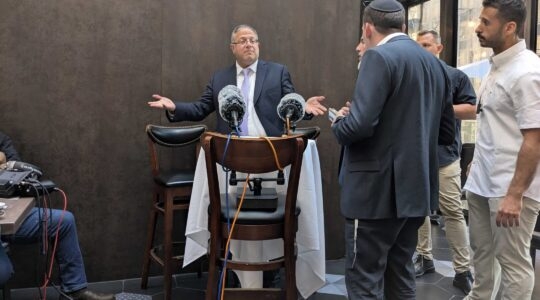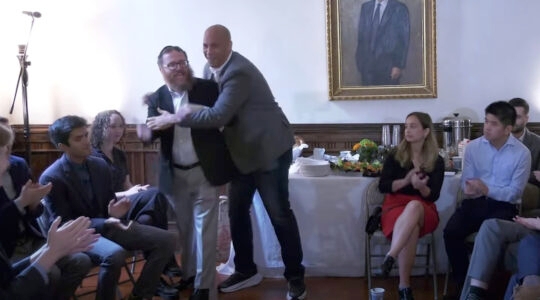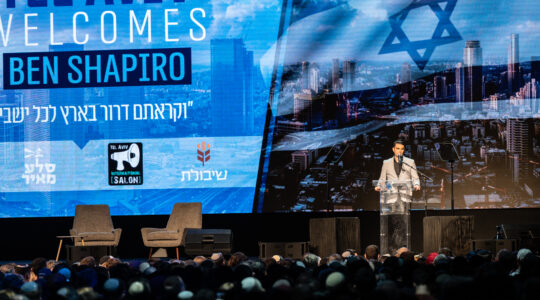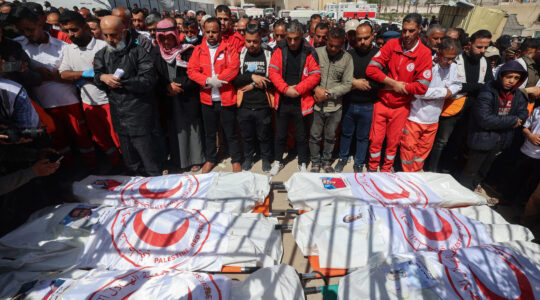YEAR IN REVIEW
JERUSALEM (JTA) — For Israel, the Jewish year 5769 was dominated by two events with far-reaching regional repercussions: the return of Benjamin Netanyahu as prime minister and the 22-day military operation against Hamas in Gaza.
Although Netanyahu’s Likud won one seat less than former Foreign Minister Tzipi Livni’s Kadima in the Feb. 10 election, the right-wing bloc of parties that supported Netanyahu’s candidacy captured 65 of the 120 Knesset seats in the vote. This enabled Netanyahu to form a 74-member coalition, with Yisrael Beiteinu, Labor, Shas, United Torah Judaism and Jewish Home joining Likud.
Sworn in on March 31, the new government immediately signaled reservations about the two-state model for peace with the Palestinians. But under strong pressure from Washington, Netanyahu quickly shifted. In a major policy speech at Bar-Ilan University on June 14, he committed his government to the notion of an independent Palestinian state alongside Israel.
"In my vision of peace, there are two free peoples living side by side on this small land, with good neighborly relations and mutual respect, each with its flag, anthem and government, with neither threatening its neighbor’s security and existence," he declared.
Still, Netanyahu attached strong caveats: The Palestinian state would have to be demilitarized, the Palestinians would have to recognize Israel as a Jewish state, no Palestinian refugees would return to Israel proper and Jerusalem would not be divided.
It was a far cry from the sweeping offer articulated by outgoing Prime Minister Ehud Olmert in the waning days of his administration. According to Olmert, in September 2008 he proposed handing over approximately 93.6 percent of the West Bank to the Palestinians, compensating for the remaining 6.4 percent or so in a land swap and a land corridor connecting the West Bank and Gaza.
Under the plan, a "very small" number of refugees would be allowed to return to Israel proper (about 2,000 a year for 10 years), Arab neighborhoods in Jerusalem would go to Palestine and Jewish neighborhoods would stay in Israel, and a special regime would run Jerusalem’s Old City until details of a solution were worked out.
Olmert even gave Palestinian Authority President Mahmoud Abbas a map reflecting the territorial proposal on the understanding that Abbas would respond within a few days.
Abbas never did.
The major change in the peacemaking equation this year was the inauguration of a new American president intent on renewing U.S. focus on bringing about Middle East peace. President Obama saw in a comprehensive U.S.-brokered Israeli-Arab peace agreement the key to regional stability, enhanced U.S. prestige and a reduction of Iranian influence in the Arab and Muslim worlds.
Special U.S. Middle East envoy George Mitchell made frequent trips to the region in an intense effort to set up productive peacemaking channels on both the Palestinian and Syrian tracks, and between Israel and the rest of the Arab world.
To create a positive atmosphere for peacemaking and to convince the Arab world of America’s evenhandedness, the White House put heavy pressure on Israel to freeze all construction in Jewish settlements, rankling many in Israel. The administration also urged moderate Arab states to take initial small steps toward normalizing relations with Israel.
But as the Jewish year drew to a close, there was still no sign of reaching the freeze-for-normalization deal the Americans were seeking as a prelude to serious peacemaking.
Among several problems, Israel wanted some exceptions to the freeze to allow for limited natural growth in the settlements, the Saudis rejected U.S. requests for steps toward normalization and the Palestinians remained paralyzed by Hamas’ continued rule over Gaza.
Indeed, earlier Israeli-Palestinian peacemaking efforts broke down when weeks of tension over the renewal of an informal cease-fire between Israel and Hamas escalated into a full-blown war in late December.
After months of escalated Hamas rocket fire into Israeli towns and cities, the Israel Air Force launched devastating bombing raids in Gaza beginning Dec. 27. The operation, called Cast Lead, would last more than three weeks and involve Israeli ground troops, ending on the eve of Obama’s inauguration.
By war’s end, Palestinian sources said 1,417 Palestinians had been killed, 962 of them noncombatants. Israel put the Palestinian death toll at 1,166 and identified 709 as militiamen and another 162 as combat-aged males. Israel suffered 13 dead, including three civilians killed by rocket fire.
The disproportionate death toll and the widespread destruction in Gaza led to claims that the Israel Defense Forces’ response to Hamas rocket attacks had been disproportionate and indiscriminate. The debate extended into the summer with the release of numerous reports about the brief war.
Israel argued that its soldiers operated strictly within the laws of war and that strenuous efforts had been made to warn civilians of impending attacks. The U.N. Human Rights Council established a fact-finding commission under South African Judge Richard Goldstone that heard testimony mainly from Palestinians. Israel refused to cooperate, claiming the commission’s mandate was inherently biased.
In late July, the Israeli Foreign Ministry issued a 164-page rejection of claims made against it by groups such as Human Rights Watch and Amnesty International. The report found that "Israel’s resort to force in the Gaza operation was both a necessary and a proportionate response" to the more than 12,000 rockets and mortars fired by Gaza militants between 2000 and December 2008. It also said that Israel was conducting its own investigation of about 100 alleged violations by soldiers in the field and had opened 13 criminal probes.
From an Israeli point of view, the Gaza operation had two major implications. Although it hurt Israel’s image overseas, the operation appeared to establish a strong deterrent balance, at least in the short term. Six months after the war, rocket fire from Gaza had nearly stopped, and Israel and Hamas were negotiating a deal behind the scenes for the release of captured IDF soldier Gilad Shalit that would include opening border crossing points into Gaza.
The Gaza operation also marked a rare setback for Iran and its proxies in Gaza, further unifying relative Arab moderates like Egypt, Saudi Arabia, Jordan and some Gulf states against Iran’s nuclear weapons’ drive.
For Netanyahu, stopping Iran from going nuclear remained a historical imperative in 5769. Israeli officials both under Olmert and Netanyahu made frequent trips to Washington to press the issue, and in late July a parade of top U.S. officials went to Jerusalem to coordinate policy on the issue.
Netanyahu’s other major preoccupation in 5769 was dealing with the impact on Israel of the global economic crisis. He passed a two-year budget with increased government spending to counteract growing unemployment, and the Bank of Israel lowered interest rates to encourage business activity.
By mid-summer the economy was showing some signs of a recovery, including strong gains on the Tel Aviv Stock Exchange, where the main indexes were up by 45 to 57 percent over the lows of December 2008.
One of the main worrying factors, however, was a rise in the national debt-to-GNP ratio, which was projected for the end of 2009 to be at 84 to 84.4 percent, up from 78.3 percent at the end of 2008.
JTA has documented Jewish history in real-time for over a century. Keep our journalism strong by joining us in supporting independent, award-winning reporting.





